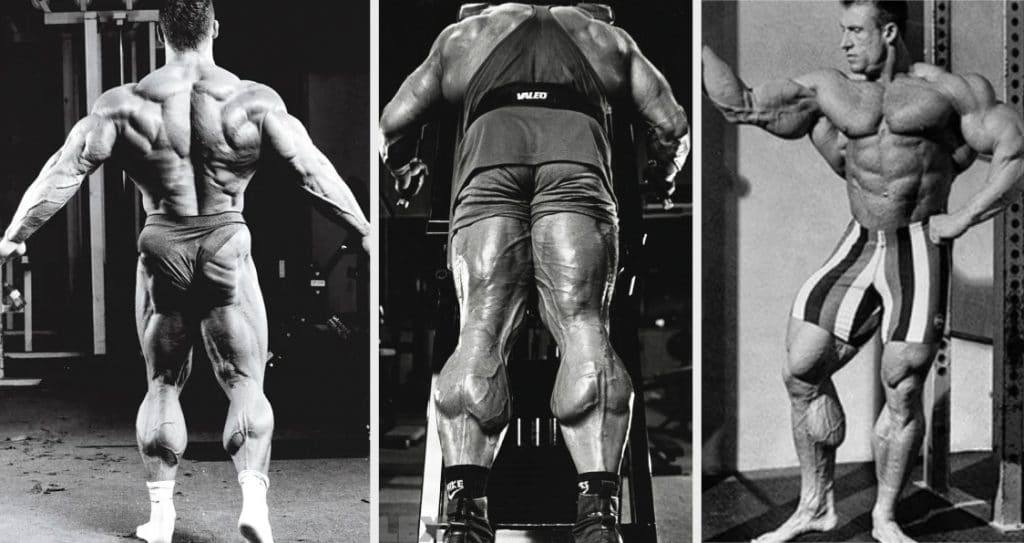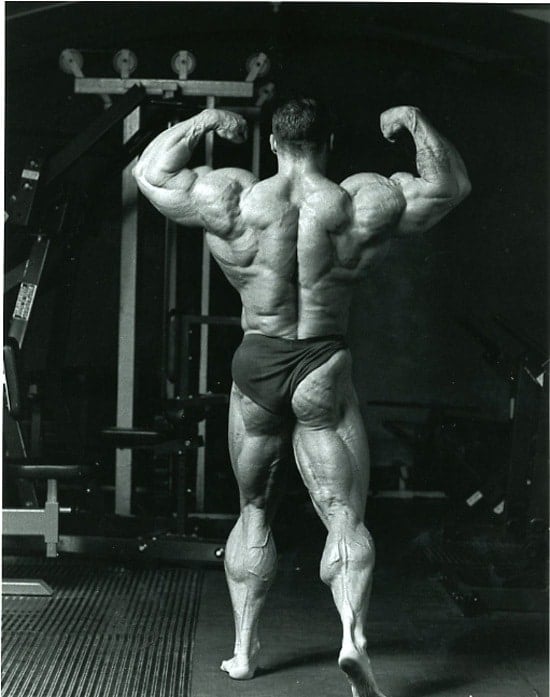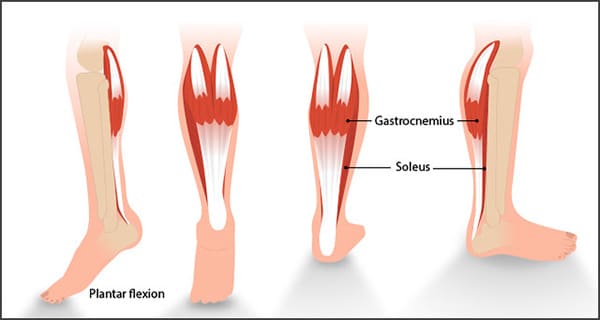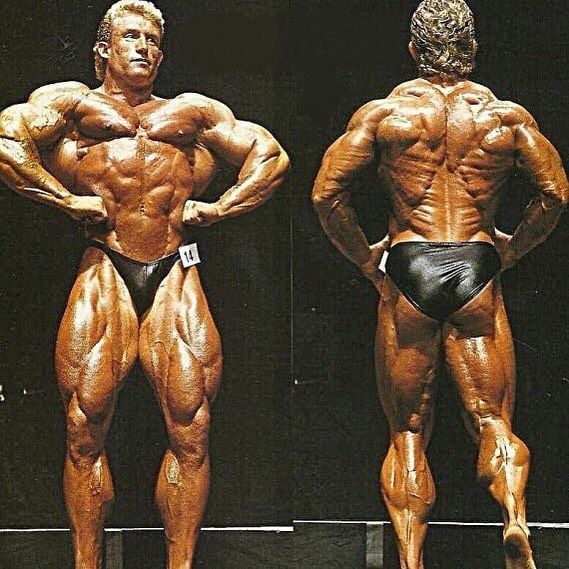The Dorian Yates Workout For Monster Calves.
Calves are one of the most stubborn muscle groups. After years of unsuccessfully training their calves, many lifters come to the conclusion that you are either born with great calves or you are not. There isn’t much you can do about them in the gym.
Before you blame your ancestors for your pencil calves, you should know that there is more than just genetics holding you back from developing your lower legs. If you want to transform your calves into full-grown bulls, you should seek advice from someone who walks the talk, and no one else fits the bill better than the 6X Mr. Olympia, Dorian Yates.
It would be safe to say that Dorian Yates changed the face of bodybuilding forever. He overshadowed his competition (the likes of bodybuilding legends such as Flex Wheeler, Kevin Levrone, and Shawn Ray) with his monstrous size and razor-sharp conditioning.
If you haven’t already, Watch: Dorian Yates: The Original Mass Monster
Dorian Yates Stats
Weight: 255 – 265lbs (115.7 – 120.2kg)
Height: 5’10” (177.5cm)
Arms: 20″
Chest: 56″
Waist: 38″
Calves: 20″
D.o.B: 19 April 1962
Birthplace: Walmley, The Royal Town of Sutton Coldfield, United Kingdom
Alias: The Shadow, The British Bulldog, The Beast of Britain
Next Read: Build a Massive Back Like The Legend Dorian Yates
The Dorian Yates Legacy
View this post on Instagram
According to Dorian, he gets calf training tips requests by the dozens every day. In this article, we will be revealing the secrets to the colossal calves that helped Yates win six Sandows.
Why should you listen to Dorian Yates, you ask?
Dorian has won 15 out of the 17 contests over his Pro league career. Also, the two losses were second-place finishes in:
- His pro debut
- His Mr. Olympia debut in ’91
And if you just skimmed through Yate’s stats, let us remind you – the guy has 20-inch calves. Most lifters do not have arms that big.
The Shadow’s giant calves helped him outdo his competition. Yates could use them in almost any pose to exert an advantage over his challengers. If you were to make a list of the 15 best calves in the history of bodybuilding – Dorian Yates would absolutely feature in the top 3.
There aren’t many pictures of Dorian Yates online (suiting for his nickname – “The Shadow”), but the ones that you can find will leave no doubts in your mind that his calves had a life of their own.
Yates had adopted a widely discredited training system (at the time) – high-intensity training (HIT) and made it his own. While training in the Dungeon, he revolutionized workout splits and body-part routines.
Check Out: Dorian Yates Still Looks Jacked at Age 58
The Calf Anatomy
To make the most of your calf workouts and to carve the lower legs of your dreams, you need to know the ins and outs of your calves. A little anatomy knowledge can take you a long way in developing muscular cows, or you could quit this article right here and be the subject of the next viral “skipped leg day” meme.
Your calf consists of two muscles: gastrocnemius and soleus. The soleus is the smaller muscle and lies underneath the gastrocnemius. The gastrocnemius, on the other hand, is the muscle that most people picture in their head when you say the word “calf“. It’s the heart-shaped muscle that contracts at the top of your lower leg, and it works to push the foot downward. It also assists in bending your knee.
Must Read: Dorian Yates’ ‘Blood & Guts’ Style Workout For Serious Growth
Training Approaches
Both calf muscles require different training approaches for optimal muscle recruitment and stimulation.
- Soleus – Standing movements (knees extended) because the soleus attaches below the knee. Eg – seated calf raises.
- Gastrocnemius – Seated movement (knees bent) since the gastrocnemius attaches above the knee. Eg – standing calf raises.
Since the soleus lies under the gastrocnemius, you will have to train the gastrocnemius at the beginning of your calf workout if you want massive and shapely calves.
We understand seated calf raises are more convenient, and you might feel a better pump while performing them, but they are also the reason you are not seeing an improvement in your lower legs.
Watch: ‘Dorian Yates: The Original Mass Monster’ Clip – Inside The Hardcore Dungeon That Was Temple Gym
Dorian Yates Calf Training Principles
1. KISS
View this post on Instagram
Before you kiss your personal trainer on the mouth, KISS – keep it simple, silly.
Dorian Yates kept his calf workouts fairly simple. According to him, most lifters make the mistake of thinking that the muscle tissue in their calves differs in biological composition from that of other muscles.
Remember – skeletal muscle is skeletal muscle, no matter where it is in your body. If you want it to grow, you need to achieve muscular hypertrophy.
Related: Dorian Yates Says Weight Training Is Best Way To Get In Shape
2. Treat Your Calves Like Any Other Muscle Group
If your legs are lagging compared to other muscle groups, revalue your lower body training and get it in line with your other workouts.
For most bodybuilders, hypertrophy is best achieved through heavy and intense training.
Watch: Dorian Yates Reveals Facts About His Post-Bodybuilding Depression
3. Train Your Calves at the End of Your Leg Workout
View this post on Instagram
While most bros will tell you to train your lagging calves at the beginning of your leg workout, Dorian Yates takes a different approach. Yates likes to fatigue his calves as quickly and efficiently as possible.
So, instead of training his lower legs on a separate day than legs, when the calves are at full strength, he works them last on leg day, when they have already been pre-exhausted by an annihilating thigh workout.
When the time comes to hit his calves, all that’s needed to finish the job are two exercises, but more on this later.
Watch: Dorian Yates Gets Real About The Crazy Steroids In The 90s
4. Have a Solid Mind-Muscle Connection
Just going through the motions for the sake of it is not going to cut it. For optimal muscle stimulation, you need to squeeze the life out of your calves at the top of every repetition.
If you cannot feel a pump in your calves while performing an exercise, following these steps should help:
- Lower the weight and focus on contracting your calves.
- Look at your calves in the mirror while performing an exercise.
- Have your training partner tap on your calves gently while you do the standing calf raise. (You could do it yourself while doing the seated calf raise).
- Perform a couple of unilateral warm-up sets.
Watch: The Best Dorian Yates Bodybuilding Motivation Video Of All Time
Most Common Calf Training Mistakes
1. Stick To Your Normal Rep Ranges
View this post on Instagram
Usually, gym-goers try to annihilate their calves by performing 25-30 reps on every set. The high-rep theory is a concept out of the broscience Bible and does not hold water.
Your calves are already conditioned to high reps since you use them all day long to walk, and your chances of shocking them into growing through high rep training are bleak. To force a muscle to grow, it must be taken to total fatigue through heavy, low reps. Focus on exhausting your calves in 10-12 reps.
Check Out: Epic! This Dorian Yates Video Shows How Hard 6-Time Olympia Champ Trained!
2. Stick to the Basics
Many lifters try to make the most of their calf workouts by using different heel and toe placements. They use an “A” feet placement (toes pointed inward and heels outward) for training their outer calves and a “V” formation (heels pointed inward and toes outward) for hitting the inner calves.
According to The Shadow, the best way to train your calves is to keep your toes pointed straight ahead. Since calves have a relatively short range of motion, you must use all of it.
Watch: Insanely Massive Dorian Yates At 1996 German Grand Prix
3. Less is More
View this post on Instagram
Dorian Yates is the king of intensity. At his peak, he only performed two exercises in his calf workout. But unlike most lifters who treat their calves as accessory muscles, Yates’ workouts were so hard that he could not go beyond the two exercises.
Check Out: Dorian Yates: “A World Without Steroids Would be Great”
4. Ego Lifting
Since calf raises have a small range of motion, most lifters let their egos get the better of them during lower leg training. They load more weight plates than they can handle and end up bouncing on their knees. If you have to use momentum, you are doing it all wrong.
If you cannot move your heels more than a couple of inches without using momentum, you should drop the weight and focus on lowering your heels to the bottom until it is only a few inches off the floor and raise them all the way to the top. At the top of the movement, you should look like a ballerina on her toes.
Must Watch: Dorian Yates Discusses Steroids With Joe Rogan
5. Not Stretching
View this post on Instagram
Dorian Yates relied on stretching to get the best bang for his buck. Benefits of stretching include:
- According to research, stretching between sets can help increase your flexibility.
- Improves your range of motion.
- Improves your performance during your workouts.
- As per a study, stretching can help increase blood flow to your muscles.
- Reduces chances of injuries.
After every set of every exercise, Yates stretches out the muscle and lets it relax. He says that if he did not stretch his calves between sets, they would cramp up so severely that he would not be able to finish his workouts.
Watch: Dorian Yates Calls His Career-Ending Injury A “Blessing In Disguise” | GI Vault
Dorian Yates Calf Workout
The Shadow kept it simple when it came to his workouts. Ready for the big reveal? You might want to sit down for this one. Here it goes:
1. Standing Calf Raise: 2 sets of 10-12 reps
2. Seated Calf Raise: 1 set of 10-12 reps
Boom! You weren’t expecting this, were you?
From the lead-up to this section, you might have guessed that Dorian did not do more than 10 sets of calf exercises, but just three sets? To be honest, we were just as shocked when we learned about this calf workout.
According to Dorian Yates, together, these two exercises chisel your calves with those deep, rocky strata and jutting promontories that indicate total development. Adding other movements, sets and reps is superfluous and may even amount to overtraining.
Related: Throwback: Dorian Yates Does The Most Intense Calf Training Ever!
Dorian Yates Calf Training Guide
1. Standing Calf Raise: 2 sets of 10-12 reps
Dorian Yates usually goes heavier on the standing calf raise, so he likes to start his calf workouts with this exercise. He does only one warm-up set of 10-12 reps and follows that with one all-out failure set of 10 reps, plus one or two forces reps in the end.
Yes, you heard it right. One out of the two sets is a warm-up set.
“I always work the bigger muscle, the gastrocnemius, first with standing calf raises. Then I do seated calf raises for the soleus. Once the gastrocnemius is fatigued, it’s easier to hit the soleus more directly.” – Dorian Yates
Steps:
- Secure your shoulders under the pads of a standing calf raise machine. Place the balls of your feet at the edge of the elevated footrest.
- If you do not have access to a standing calf machine at your gym, you could use a Smith machine by placing an aerobic step under the Smith machine bar.
- Keep your legs straight, with just a very slight bend in your knees, and press your heels down toward the floor to stretch your calves.
- Your heels should be only a few inches away from the floor at the bottom of the movement.
- Raise your heels by contracting the calf muscles to rise as high as you can on the balls of your feet.
- Pause and contract your calves at the top of the movement.
- Lower back to the starting position with a slow and controlled motion.
- Repeat for recommended reps.
2. Seated Calf Raise: 1 set of 10-12 reps
Dorian Yates does not feel that a warm-up set is necessary on the seated calf raises, so he performs one all-out set for 10 reps, plus one or two more forced reps at the end.
Steps:
- Take a seat on the calf machine and place the balls of your feet on the platform with your toes pointed forward.
- Position the base of quads under the knee pad and allow your hands to rest on top.
- Extend at your ankles and release the safety bar.
- Lower your heels until the calves are fully stretched and your heels are only a few inches away from the floor.
- Extend the ankles and lift your heels as high as you can without using momentum or a bouncing motion.
- Pause and contract your calves at the top of the movement.
- Slowly return to the starting position.
- Repeat for recommended repetitions.
Remember: It took Yates nearly 10 years to evolve to his one-main-set-per-exercise strategy. Beginners and intermediates should perform two or three sets per exercise.
Conclusion
We know what you are thinking. Just two exercises and three sets in the name of calf training?
That is Dorian Yates’ intensity for you.
There is a lesson to be learned through this training routine. The 80/20 principle applies to your workouts as well. 80% of the output results from 20% of all inputs. So, stop wasting your time performing 15 sets in your calf workouts and focus on doing six sets of the Dorian Yates calf workout well.
Who do you think has better calves than Dorian Yates? Let us know in the comments below. Also, be sure to follow Generation Iron on Facebook, Twitter, and Instagram.











